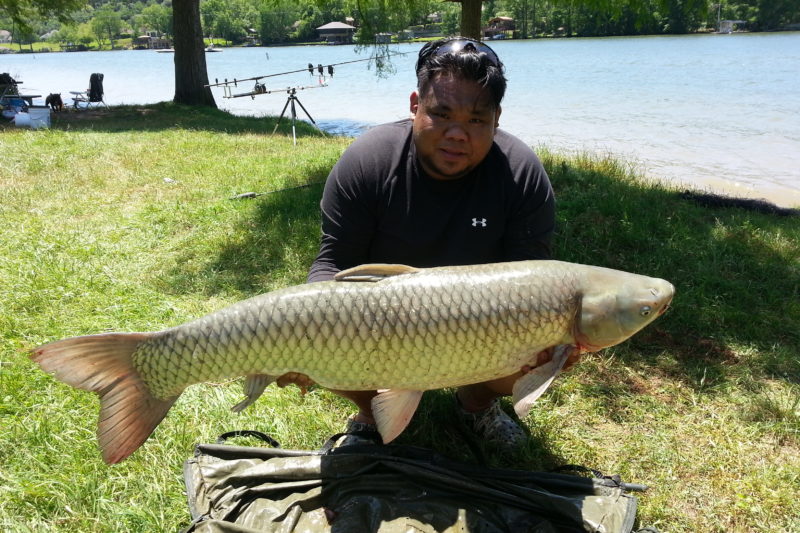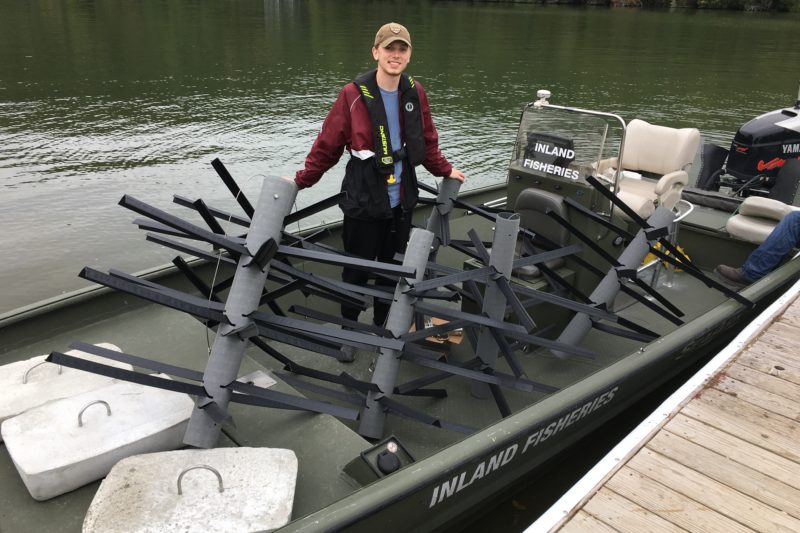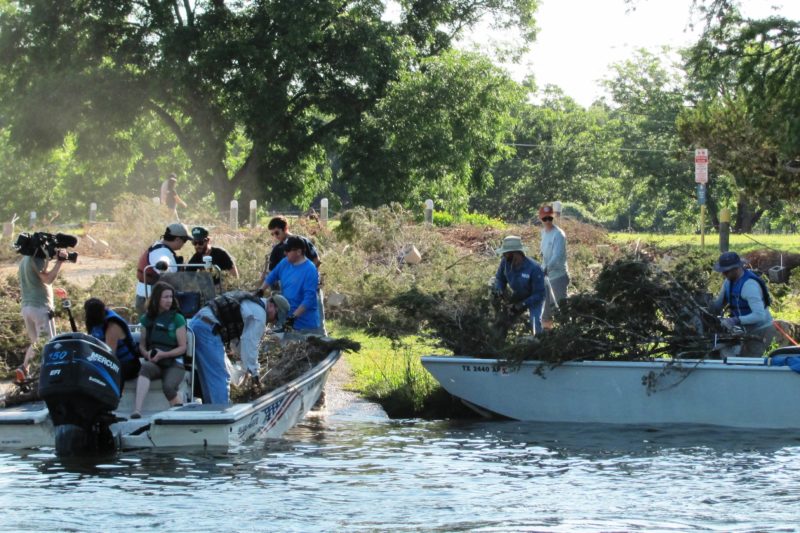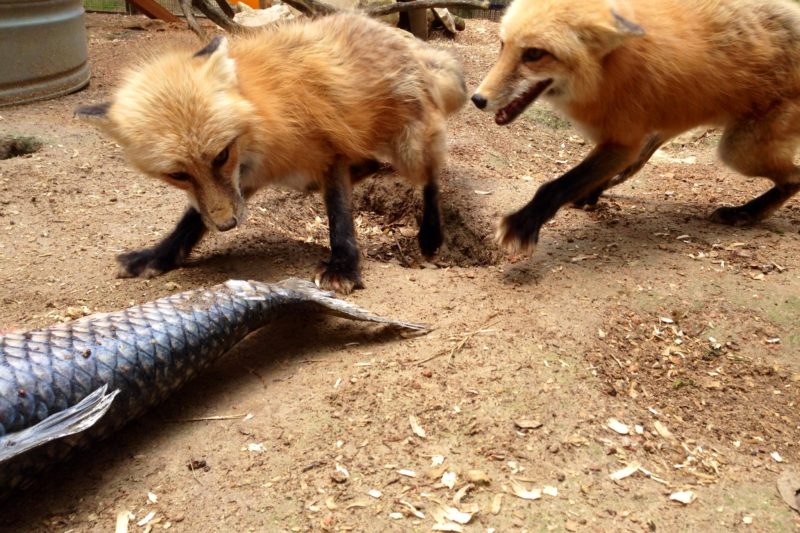Renewing Battle Against the Fish Eating Lake Austin
By Aimée Knight
Reporting Texas

Joseph Raguro, a member of the Austin Carp Anglers, holds a grass carp he caught during a coordinated mass carp removal effort with the City of Austin in 2015. Courtesy Mukhtar Farooqi
Wildlife management officials are beginning a new chapter in a long-running struggle to reduce the number of grass carp prowling Lake Austin’s watery underworld.
Last November, the Texas Parks and Wildlife Department placed structures known as Mossback fish habitats at 13 sites on the lakebed. Designed to look and feel like real fish cover, they resemble skeletons of artificial Christmas trees: Jutting out from a “trunk,” a single upright metal pipe, are the “limbs,” multiple horizontal pipes.

Noah Turner, a volunteer at Texas Parks and Wildlife, deploys weighted Mossback fish habitats in Lake Austin in November 2019. Courtesy Mukhtar Farooqi
Officials are deploying the contraptions to remedy the damage grass carps’ voracious appetites for vegetation have done to the lake’s prized largemouth bass population and other fish species that depend on vegetative cover to survive.
Officials introduced the carp, 18-inch-long herbivorous fish, to Lake Austin in 2002 as a biological control for hydrilla, a fast-growing aquatic plant. For almost a decade, supplemental stocking by city officials successfully mitigated the hydrilla’s growth. But since 2011, finding a balance between carp and cover has proved elusive.
“Since the grass carp were added to the lake, we’ve been trying incrementally to make it rebound,” Mukhtar Farooqi, assistant district supervisor for Austin fisheries at Texas Parks and Wildlife, said.
The tension between hydrilla-control efforts and their unintended consequences have left some Austin anglers resentful over the collapse of what was one of the state’s premiere bass fishing locations. Because of how notoriously difficult carp populations are to measure, tensions may not dissipate anytime soon.
The lake reached a tipping point in 2011. Unfettered hydrilla growth led City of Austin officials to put larger numbers of the sterilized grass carp in the lake. Over the next two years, 30,000 of the fish were pumped in.
“The carp did what they were put there to do,” Kevin Olivier, president of Austin Carp Anglers said, “which was eat.”
And eat they did. The carp eliminated the hydrilla but also dined on other aquatic vegetation like milfoil that largemouth bass and other fish populations rely on for food and cover. Largemouth bass numbers dwindled, and Lake Austin fell in bass-fishing repute.
“They crashed the lake,” Olivier said, adding a saying favored by his carp-angling club members: “When man makes plans, God laughs.”
When hydrilla was at its peak, said Martin Jakubowsky, treasurer of the Austin Bass Club, “we were catching record numbers of quality bass,” and anglers considered Lake Austin one of the state’s premiere fishing venues. In 2014, Bassmaster Magazine ranked the lake No. 1 in Texas and 8th among the nation’s 100 best bass-fishing lakes.
Jakubowsky says his club once held monthly tournaments on Lake Austin but has since moved them to Lady Bird Lake or the Highland lakes.
“Nobody wanted this to occur,” Farooqi said.
The Mossback fish habitats’ limbs are textured to promote algae growth and should benefit any fish species in the lake, Farooqi says. Once the smaller fish, like redbreast sunfish, are attracted to the structures, they will in turn draw predators like largemouth bass.
“You need the whole fish assemblage to make it work,” Farooqi said. Texas Parks and Wildlife will sample fish populations every two years and publish a report on a four-year basis. The next report is due out next year.
A healthy lake needs about 20% to 40% vegetative cover, Farooqi says, and right now Lake Austin has none.
City officials are working toward restoring vegetation by setting up herbivore exclosure pens. The pens, which extend from 20 feet below to three feet above the waterline, protect newly planted shoreline vegetation from turtles and grass carp.
“The long-term solution is getting the vegetation re-established,” said Brent Bellinger of the city’s watershed protection department. “The young bass need insects and small minnows to feed on, and the big bass need bluegill and they’re all dependent on aquatic vegetation.”
In 2015, Texas Parks and Wildlife began placing bundles of cedar trees at sites in the lake to establish natural habitats. However, major flooding in 2016, 2018 and 2019 washed them along with some of the carp over the Tom Miller Dam into Lady Bird Lake.

Texas Parks and Wildlife employees and volunteers from the Texas Tournament Zone deploy bundles of cedar trees to act as natural fish habitats. Courtesy Mukhtar Farooqi
Another 2015 effort by Texas Parks and Wildlife saw the Austin Carp Anglers club recruited to harvest as many carp as possible, which depleted the total count somewhat.
“The Austin Carp Anglers took out 2,678 pounds,” Farooqi said, “with the biggest carp weighing 49 pounds. So they removed not a bad amount of biomass there.” The project partnered with the Austin Zoo and composting company Organics By Gosh to use the catch. (Farooqi says the zoo sent them pictures of Russian red foxes and bears nibbling on the fish.)
The city also revoked the ban on keeping grass carp fished from Lake Austin in September 2016. “That was to help get rid of the fish by allowing any anglers or bow fisherman … to go and take those grass carp out,” Farooqi said.
Kevin Oliver, who was involved in the 2015 mass fishing effort, says that despite the lifted ban, grass carp aren’t the favored fish for carp anglers.
“They’re not a great sports fish,” Olivier said. “We’re looking for fish that are keen and aware, something that’s going to put up a fight. Grass carp … they’re kind of like a wet towel when you reel them in.”
The current tally of grass carp is difficult to determine, as the fish are notoriously challenging to sample, Farooqi says. The method of sampling the department uses, known as electrofishing, utilizes electrodes attached to their boats to stun the fish for capture, weighing and release.
“The grass carp are pretty wary,” Farooqi said. “As soon as they feel the tingling of that electricity, they shoot off in the other direction.” Attempts at netting the fish, too, have proven ineffective; They’re so wily, Farooqi says, the carp will swim under or jump over and out of the net.
With the average lifespan of a grass carp ranging from nine to 15 years, their numbers in Lake Austin should dip below the desired threshold for lake health by 2023, Farooqi says.
Although the lake environment continues to suffer from its grass carp infestation, anglers and city scientists agree the hydrilla’s growth demanded to be addressed. The 2009 drought caused warmer water temperatures and reduced flow into the lake, accelerating the plant’s growth. By 2011 hydrilla had become so pervasive it occupied 600 acres – almost 40% ¬ of Lake Austin.
Unmitigated growth meant reduced boating and other recreational uses, the loss of the crystal-clear waters desired by shoreline homeowners, potential damage to the Tom Miller Dam’s flood gates and an increased threat of flooding. Bellinger estimates flood-related damage from leaving the hydrilla unmanaged would have cost hundreds of thousands of dollars.
“We obviously want an ecosystem that is in balance and provides services to a wide range of users,” he said, “but something that’s going to affect dam operations … that definitely requires management.”
Part of the overall problem is Lake Austin’s shoreline development, Bellinger says. The natural process of trees dying and falling into the water – as would typically occur along a lake and provide essential cover and bolster aquatic ecosystem health – is lost as property owners manage their lakefront space.
“Unfortunately, along Lake Austin most of the shoreline has been developed, and people remove brush, shrubs and a lot of trees from their property,” Bellinger said.
Navigating the interests of the parties invested in the lake’s health and utility is a tricky line to walk. Homeowners, for their part, basically want a “swimming pool” to front their properties, Bellinger said. “They want something that’s sterile and clear. They don’t want to look at trees, they don’t want to look at vegetation. They want sandy beaches.”
The committee responsible for the decision to stock the additional grass carp in 2011, triggering the vegetation and fish loss, was comprised of representatives from Texas Parks and Wildlife, the City of Austin and homeowner’s advocacy group Friends of Lake Austin.
“The committee had to make a call based on all the information available,” Farooqi said. “And we learn from experience. Everyone’s still stunned that it happened, and we’re trying to wait for the turnaround to occur.”
The coordinates of the mossback habitats are available for interested anglers to serve as targeted fishing spots as they wait for the vegetation to regrow, Farooqi says. For now, he’s optimistic. “They’ve been shown to be effective in attracting and holding fish. So they’ll work in the areas we put them in.”
